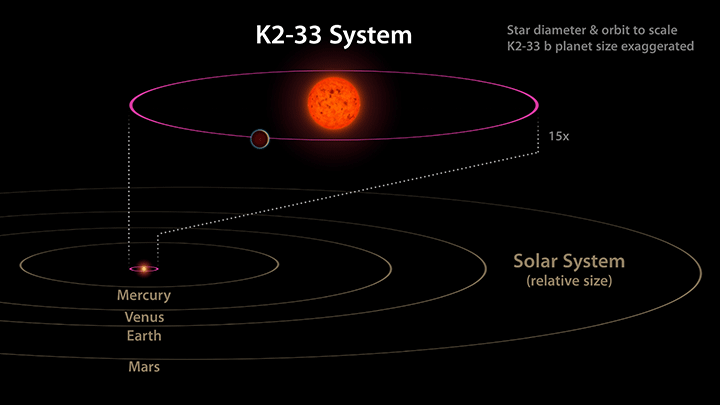When it comes to the cosmos, this newly discovered exoplanet is a mere infant.

Using NASA’s Kepler Space Telescope, astronomers have found a planet slightly larger than Neptune orbiting another star.
The planet — K2-33b — orbits a star that is just five to 10 million years old every 5.4 days. That means that the planet itself is much younger than that.
READ MORE: Astronomers get first glimpse of planet being born
When you consider that Earth is about 4.5 billion years old, you can see why astronomers are calling this a newborn.
What makes this discovery particularly interesting is how close this gas giant is to its host star, K2-33 — 10 times closer than Mercury is to our sun. Mercury, the first planet in our solar system, orbits roughly 60 million kms from the sun and takes 88 days to complete.
Theories have suggested that planets of that size forming so close to its star were unlikely; that instead, any planet found that close could be a result of a planet that migrated inward toward the star. However, this revelation calls that theory into question.
“After the first discoveries of massive exoplanets on close orbits about 20 years ago, it was immediately suggested that they could absolutely not have formed there, but in the past several years, some momentum has grown for in situ formation theories, so the idea is not as wild as it once seemed,” said Trevor David of Caltech in Pasadena, lead author of the paper published in the science journal Nature.
READ MORE: Newly discovered planet is the largest orbiting two stars
“The question we are answering is: did those planets take a long time to get into those hot orbits, or could they have been there from a very early stage? We are saying, at least in this one case, that they can indeed be there at a very early stage,” he said.
The discovery is also important as astronomers hope that, by observing this baby planet, they can better understand planet formation.
Stars and planets form out of a rotating cloud of dust and gas. After the star forms, the remaining debris flattens as it rotates. This is called a protoplanetary disk, where planets will begin to form.
There are a few methods astronomers use to search for exoplanets, or planets orbiting other stars. One involves using space-based telescopes, such as Kepler, to look at stars and measure any dimming that might occur. The dimming could indicate that a planet is passing in front of the star, blocking out marginal starlight. That is how K2-33b was found.
Observations by Kepler also detected a protoplanetary disk surrounding K2-33.



Comments